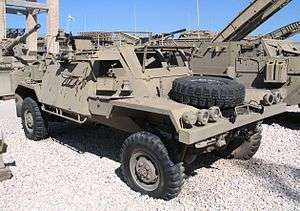RBY MK 1
The RBY Mk 1 is a light armoured reconnaissance vehicle that was produced by the RAMTA Division of Israel Aircraft Industries. RBY is and anglicized acronym for "Rechev Ben-Yaacov". "Rechev" is Hebrew for "vehicle" and "Ben-Yaacov" is the last name of the creator of the vehicle, Yitzchak Ben-Yaacov (1919-2011). In Israel the vehicle is known as the "Rabi", a pronunciation of the acronym. It was replaced in Israeli service by the RAMTA RAM 2000 family of vehicles, though it continues to be used and upgraded by foreign users.[1] The RBY Mk 1 is no longer marketed to new customers.
| RBY MK 1 | |
|---|---|
 RBY MK I at the Yad la-Shiryon Museum, Israel. | |
| Type | Reconnaissance vehicle |
| Place of origin | |
| Service history | |
| In service | 1975-present |
| Used by | Current Honduran Army Guatemalan Army Lesotho Army Former: Israel Defense Forces |
| Wars | Guatemalan Civil War FMLN-Honduran skirmish |
| Production history | |
| Designer | IAI RAMTA |
| Designed | 1975 |
| Produced | 1975 |
| Specifications | |
| Mass | 3600 kg |
| Length | 5.023 m (16.48 ft) |
| Width | 2.030 m (6.66 ft) |
| Height | 1.660 m (5.45 ft) |
| Crew | 2 (+6 passengers) |
| Armour | 8 mm (0.31 in) steel (hull sides) 10 mm (0.39 in) steel (floor) |
Main armament | Up to 5 machine guns (pintle mounts) |
| Engine | Chrysler 225-2 6-cylinder petrol[1] or 6.8 litre V-8 diesel (Guatemalan RBY Mk 1 only) or Deutz BT6L 912S inline-V6 diesel engine (Honduran local upgrade)[2] 120 hp or 145 hp depending on variant |
| Power/weight | Depends on Variant |
| Maximum speed | 100 km/h (62 mph) |
Design
The RBY Mk 1 with a variety of potential applications in mind, including reconnaissance, commando operations, internal security, and long range patrols.
Considerable design effort was put into making the vehicle mine resistant - the wheels and axles were placed as far forward and backward as possible to maximize the distance of any detonation away from the crew and passengers, the bumpers were made of fiberglass so they would disintegrate in an explosion and minimize hazardous debris, and the thickest armour was incorporated into the floor, and the floor and hull were shaped to channel explosions away from the vehicle. Outside of the modified Guatemalan versions, the RBY Mk 1 had no doors (crew entered through the open-topped passenger compartment) to ensure that the hull had no weak points.[1]
The weight of the vehicle was kept light enough to make it transportable by heavy lift helicopters, such as the CH-53 Sea Stallion.[1]
While the RBY Mk 1 featured no integral armament, provisions were made for up to five machine guns by placing pintle mounts at various points around the vehicle.
Passenger seating was provided with two, back-to-back rows of three outward-facing seats. This allowed the passengers maintain a full 360 degree field of view, and operate any mounted machine guns.
Guatemalan Upgrades
In the mid to late 1990s, the Guatemalan Army began testing an upgraded and modified RBY MK 1. The new RBY MK 1 featured a new, more powerful diesel engine, and a kevlar roof for what had been the open cargo/passenger box, and access doors on either side of the vehicle for the now enclosed rear compartment. The roof incorporated a ring mount for a machine gun.[3]
Variants
RBY Mk 1 Anti-tank - A modified version of the RBY Mk 1 was produced which featured a 106mm recoilless rifle,[2] 16 rounds of ammunition and crew positions in place of the normal passenger seating.
Operators
See also
"Combat Reconnaissance/Patrol Vehicle" with rear engine:
Others:
- RG-31 Nyala - A more modern mine protected vehicle
- MRAP - A family of vehicles designed to survive mine attacks and improvised explosive devices
External links
| Wikimedia Commons has media related to RBY. |
References
- "Jane's Armour and Artillery: RAMTA RBY Mk 1 light armoured reconnaissance vehicle (Israel), Reconnaissance vehicles". Jane's Information Group. 2008-09-04. Archived from the original on 28 July 2009.
- Montes, Julio A. (2 January 2015). "Infantry Support and Anti-tank Weapons in Latin America: 90mm and 105mm Recoilless Rifles". Small Arms Defense Journal. Vol. 6 no. 4.
- "Jane's International Defence Review: GUATEMALA - TRIALS RBY MK 1, Upgrade Update". Jane's Information Group. 1998-06-12. Archived from the original on 26 July 2009.
- "Trade Registers". Armstrade.sipri.org. Retrieved 2014-11-20.